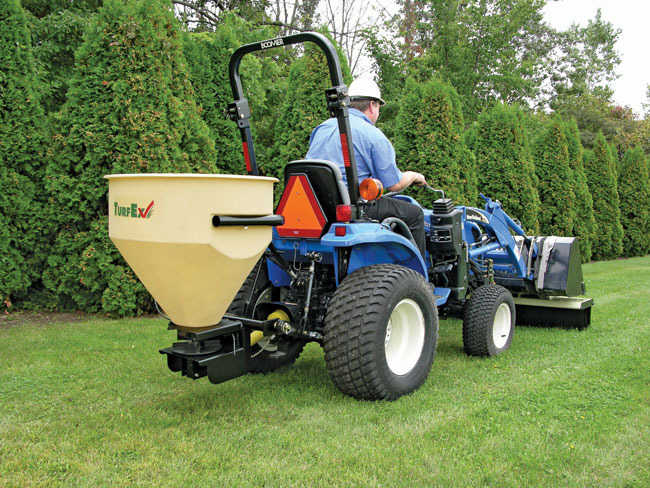Spread the News
Maintaining large areas of turf requires a large spreader. So if that push spreader in the back of the tool shed takes most of a day to finish one job, it’s time to look for something better. Fortunately, the solution may be simple, thanks to PTO-driven spreaders. There are many types of spreaders available on the market, including gas-powered, electric-powered and even self-propelled units. But for people with compact tractors, PTO-driven spreaders may be the way to go. In fact, hobby farmers, estate owners, property managers and sportsfield superintendents have been using them for years as a way to cover a lot of ground while getting more use out of their tractors.

Most popular for spreading seed and fertilizer, spreader attachments are typically capable of spreading a wide variety of pelletized materials. Their versatility even extends into the winter, when they can be used to distribute ice melters. In recent years, the quality of PTO-driven spreaders has increased dramatically. For example, some manufacturers are now constructing hoppers from lightweight, corrosion-free polyethylene instead of steel. Other features, such as adjustable spinner fins and calibration tools, are also being incorporated to create the perfect spread pattern and help operators apply material precisely.
PTO-driven spreaders have been successful largely because of their simplicity. These units are self-contained, so there are no hydraulics, engines or motors to worry about, and maintenance is kept to a minimum. Besides keeping the U-joints well greased, there aren’t many other requirements to keep the spreaders running in top condition. Because PTO-driven spreaders aren’t equipped with their own drive systems, they’re cheaper than many other types of spreaders on the market that come with hydraulics or engines. Not only does the end-user save money on the spreader purchase, but he or she also adds to the versatility of the compact tractor by utilizing the power take-off for new tasks.
Most PTO-driven spreaders on the market are suited for Category I and II three-point hitches, although some manufacturers also offer spreaders for Category 0 hitches. Furthermore, horsepower requirements are minimal, as many spreaders will operate on just 26 hp. Compact tractors generally provide more than enough torque to keep the spinners turning as well. Just like any other PTO-powered tool, spreader attachments are dependent on the tractor keeping a steady RPM. Furthermore, the tractor must be driven at a consistent speed to ensure an even spread rate. If the tractor slows down, the application will become thicker, and if the tractor speeds up, material will be spread thinner.
Keeping a consistent speed and RPM presents the biggest challenge on hilly terrains. The tractor may tend to bog down when climbing elevation, or it may speed up when going downhill. Therefore, the operator must manage the throttle well in order to achieve an even spreading application. As long as the operator maintains a steady speed and RPM, PTO-driven spreaders can deliver a precise, measurable amount of material. Plus, many manufacturers offer calibration tools, so people can customize their spreader settings for the exact types of materials they use. Thanks to this feature, end-users reduce the risk of being ineffective from not spreading enough material, and they won’t damage the turf from spreading too much.
With PTO-driven spreader attachments, compact tractors are more than ready to tackle turf care. It’s an economical, yet productive way to distribute seed, fertilizer and other materials. Not to mention, it’s a great way to add even more versatility to a tractor.
James Truan is the vice president of sales and marketing at TurfEx, based in Madison Heights, Mich.
